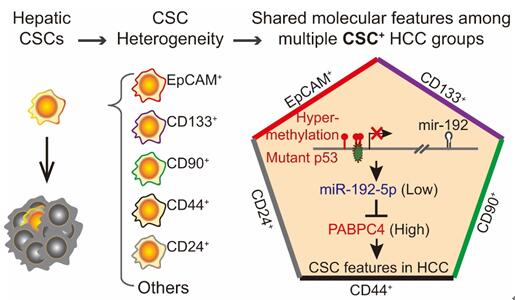Analysis on liver cancer subpopulation identifies the key role of one microRNA
The research team led by JI Junfang from the Life Sciences Institute, Zhejiang University, published an article entitled “miR-192-5p silencing by genetic aberrations is a key event in hepatocellular carcinomas with cancer stem cell features” in the December 7 issue of Cancer Research. It opens up a feasible and effective approach to targeting hepatocellular carcinomas with cancer stem cell features.
Primary liver cancer is the second leading cause of cancer deaths worldwide and approximately 90% is hepatocellular carcinomas (HCC). Cancer stem cells are perceived as the culprit of the incidence and progression of tumor. Various cancer stem cell (CSC) biomarkers have been identified for HCC, but little is known about the implications of heterogeneity and shared molecular networks within the CSC population.
Through miRNA profile analysis in a HCC cohort (n=241) for five groups of CSC+ HCC tissues, i.e., EpCAM+, CD90+, CD133+, CD44+, and CD24+ HCC, researchers identified a 14-miRNA signature commonly altered among these five groups of CSC+ HCC. MiR-192-5p, the highest-ranking CSC-miRNA, was liver-abundant and -specific and appeared markedly downregulated in all five groups of CSC+ HCC from two independent cohorts (n=613). Suppressing miR-192-5p in HCC cells significantly increased multiple CSC populations and CSC-related features through targeting PABPC4. Both TP53 mutation and hyper-methylation of the mir-192 promoter impeded transcriptional activation of miR-192-5p in HCC cell lines and primary CSC+ HCC.

This study reveals the circuit from hyper-methylation of the mir-192 promoter through the increase in PABPC4 as a shared genetic regulatory pathway in various groups of primary CSC+ HCC. This circuit may be the driving force that steers liver cells toward hepatic CSC cells, thereby leading to hepatic carcinogenesis.
This finding not only contributes to a more insightful understanding of the heterogeneity of cancer stem cells but also reveals the potential role of miR-192-5p as a molecular therapeutic target for HCC.